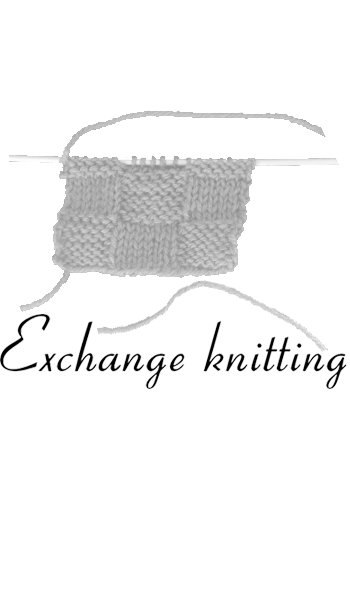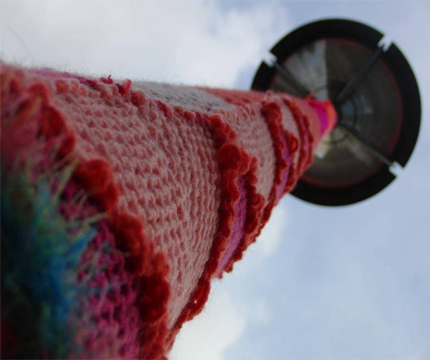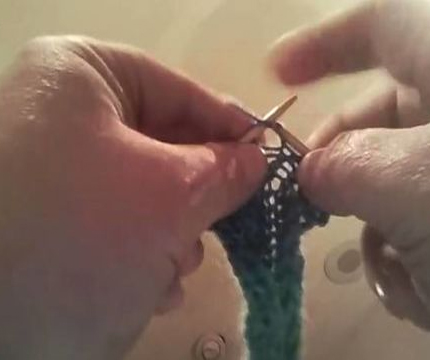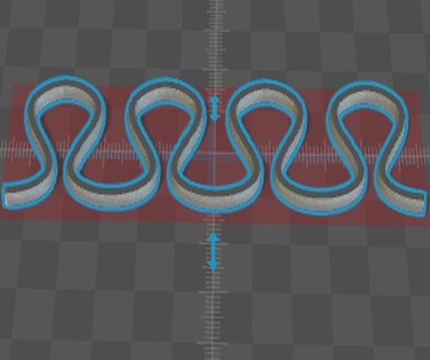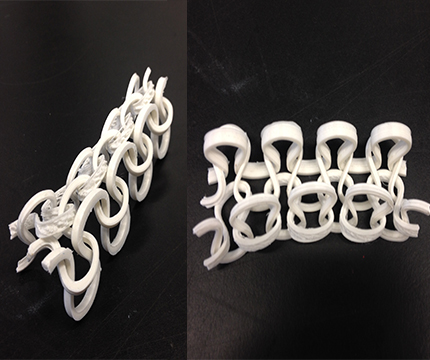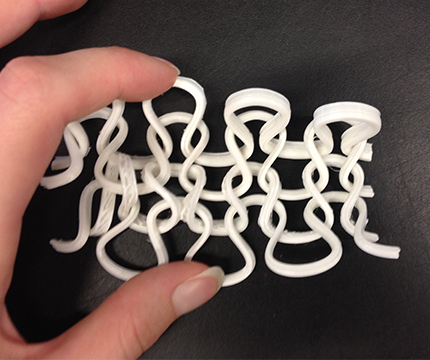Difference between revisions of "Guerilla Knitting"
| (20 intermediate revisions by 2 users not shown) | |||
| Line 1: | Line 1: | ||
__NOTOC__ | |||
[[File: | [[File:front-image_guerillaknitting.png]] | ||
=== | |||
===Introduction=== | |||
[[File:guerillaa.jpg]] | |||
For my project I started to connect with a knitting community called GuerillaKnittingGroup. The reason I chose this path is because I, as a fashion designer, am eager to learn more about techniques and want to specialize more in knitting. GuerillaKnittingGroup wants to cheer up the city by hanging colorful knitted pieces on trees, poles and other ‘daily ugly’ objects as they call it. Allthough they are not very active at the moment because of their own busy life, the four regular members still like to knit and maybe reconnect later on. | For my project I started to connect with a knitting community called GuerillaKnittingGroup. The reason I chose this path is because I, as a fashion designer, am eager to learn more about techniques and want to specialize more in knitting. GuerillaKnittingGroup wants to cheer up the city by hanging colorful knitted pieces on trees, poles and other ‘daily ugly’ objects as they call it. Allthough they are not very active at the moment because of their own busy life, the four regular members still like to knit and maybe reconnect later on. | ||
| Line 8: | Line 13: | ||
these interviews I discovered various things. | these interviews I discovered various things. | ||
=== | ===Contact=== | ||
The regular members of this group are Betty, Rénia, Monika and Helga. I spoke with Betty and Rénia and they started this initiative 4/5 years ago. Besides the group, Betty works in an atelier in Rotterdam, Rénia keeps the Facebook page up to date and works fulltime and other member Monika has her own small business and is also a fulltime mother. | The regular members of this group are Betty, Rénia, Monika and Helga. I spoke with Betty and Rénia and they started this initiative 4/5 years ago. Besides the group, Betty works in an atelier in Rotterdam, Rénia keeps the Facebook page up to date and works fulltime and other member Monika has her own small business and is also a fulltime mother. | ||
=== | ===Knowledge=== | ||
The first interview with Rénia was on the phone, from this interview I noted the important and most interesting things. She told me that she has arthritis and that it is sometimes hard to knit (I will go deeper on this aspect -> the prototype). She also appears to be inventive with connecting patches together and shares this with her colleagues. She taught Betty to stitch with a contrast, so that there will arise an edge between the patches. | The first interview with Rénia was on the phone, from this interview I noted the important and most interesting things. She told me that she has arthritis and that it is sometimes hard to knit (I will go deeper on this aspect -> the prototype). She also appears to be inventive with connecting patches together and shares this with her colleagues. She taught Betty to stitch with a contrast, so that there will arise an edge between the patches. | ||
[[file:stitch.jpg|stitch.jpg]] | |||
The knitted pieces are made at home and will later on be attached at a chosen location which they think is quite dull and could use a cheer up. Not only for that location and object, but also for the people who come by every day. | The knitted pieces are made at home and will later on be attached at a chosen location which they think is quite dull and could use a cheer up. Not only for that location and object, but also for the people who come by every day. | ||
| Line 23: | Line 28: | ||
garment a bit different. This saves some motion in the hands and no pain. | garment a bit different. This saves some motion in the hands and no pain. | ||
[[file:continental.jpg|continental.jpg]] | |||
I was also interested in the way they wrap the knittings to a pole or fence. Betty explained that she used the technique from Rénia to connect the patches to each other. To hold the knitting in place and won’t slide down, she used a metal thread on top that is connected to the work. | I was also interested in the way they wrap the knittings to a pole or fence. Betty explained that she used the technique from Rénia to connect the patches to each other. To hold the knitting in place and won’t slide down, she used a metal thread on top that is connected to the work. | ||
| Line 29: | Line 34: | ||
The third interview with Monika (aka Maluca Yarnbombing) it unfortunately still underway. What I do know about her and what she told me in an email is that she misses GuerillaKnitting very much and she wants to continue as soon as spare time will let her do that. She also runs a small business for herself that is called: Buubok. She sells these handmade goods via Etsy. These goods are various knitted lampshades, crocheted clutches, toys and rugs. To make al these goods she has to possess many techniques and that makes it for me interesting. | The third interview with Monika (aka Maluca Yarnbombing) it unfortunately still underway. What I do know about her and what she told me in an email is that she misses GuerillaKnitting very much and she wants to continue as soon as spare time will let her do that. She also runs a small business for herself that is called: Buubok. She sells these handmade goods via Etsy. These goods are various knitted lampshades, crocheted clutches, toys and rugs. To make al these goods she has to possess many techniques and that makes it for me interesting. | ||
The knowledge of this group is divers but most of all related to various techniques. They all have started with their own technique(s), but because of the shared knitting sessions they taught from each other, which intrigue me to co-operate with them for my follow up project, 'Exchange knitting'. | The knowledge of this group is divers but most of all related to various techniques. They all have started with their own technique(s), but because of the shared knitting sessions they taught from each other, which intrigue me to co-operate with them for my follow up project, 'Exchange knitting'. | ||
=Prototype= | =Prototype= | ||
[[file: | [[file:proto 3D.jpg]] [[file:prototype 3D.jpg]] | ||
===New knitting=== | ===New knitting=== | ||
My prototype is a 3D printed knitting loop that is multiplied and connects with each other so that it looks like the normal knitting technique. Because I made it with flexible material it can bend and be a bit reshaped. I used the flexible material because my intension is to use it for artistic clothing, so it comes in handy that it is bendable. The idea of this technique came from the first interview I did with Rénia and focused on the pain she has in her hands while knitting. This pain comes from knitting with the needles. Therefore I designed this prototype as a new way of knitting without using needles and creating pain from the hand movements. This is a different insight for knitting for the people who are interested. This 3D printed piece is made in Rhinoceros and can be customized or taken over by anyone with the online blueprints, so that makes this an open form. Putting this online is for limited people, because this it is not the pain solution for knitters. I can imagine that this is for very creative people who want to make, for example, a sweater from different material and with a different technique. It takes some time, but it can be a very artistic piece of art. You can customize the sizes of the loops to your design so it will fit all together. This will definitely not be the first 3D printed clothing, because Dutch fashion designer Iris van Herpen uses this 3D printing technique for quite some time in her collections. | My prototype is a 3D printed knitting loop that is multiplied and connects with each other so that it looks like the normal knitting technique. Because I made it with flexible material it can bend and be a bit reshaped. I used the flexible material because my intension is to use it for artistic clothing, so it comes in handy that it is bendable. The idea of this technique came from the first interview I did with Rénia and focused on the pain she has in her hands while knitting. This pain comes from knitting with the needles. Therefore I designed this prototype as a new way of knitting without using needles and creating pain from the hand movements. This is a different insight for knitting for the people who are interested. This 3D printed piece is made in Rhinoceros and can be customized or taken over by anyone with the online blueprints, so that makes this an open form. Putting this online is for limited people, because this it is not the pain solution for knitters. I can imagine that this is for very creative people who want to make, for example, a sweater from different material and with a different technique. It takes some time, but it can be a very artistic piece of art. You can customize the sizes of the loops to your design so it will fit all together. This will definitely not be the first 3D printed clothing, because Dutch fashion designer Iris van Herpen uses this 3D printing technique for quite some time in her collections. | ||
[[file: | [[file:protot 3D.jpg|protot 3D.jpg]] | ||
Latest revision as of 16:08, 28 December 2015
Introduction
For my project I started to connect with a knitting community called GuerillaKnittingGroup. The reason I chose this path is because I, as a fashion designer, am eager to learn more about techniques and want to specialize more in knitting. GuerillaKnittingGroup wants to cheer up the city by hanging colorful knitted pieces on trees, poles and other ‘daily ugly’ objects as they call it. Allthough they are not very active at the moment because of their own busy life, the four regular members still like to knit and maybe reconnect later on. To figure out what their needs are and if they are missing anything in the group, I did some interviews with a few members. From these interviews I discovered various things.
Contact
The regular members of this group are Betty, Rénia, Monika and Helga. I spoke with Betty and Rénia and they started this initiative 4/5 years ago. Besides the group, Betty works in an atelier in Rotterdam, Rénia keeps the Facebook page up to date and works fulltime and other member Monika has her own small business and is also a fulltime mother.
Knowledge
The first interview with Rénia was on the phone, from this interview I noted the important and most interesting things. She told me that she has arthritis and that it is sometimes hard to knit (I will go deeper on this aspect -> the prototype). She also appears to be inventive with connecting patches together and shares this with her colleagues. She taught Betty to stitch with a contrast, so that there will arise an edge between the patches.
The knitted pieces are made at home and will later on be attached at a chosen location which they think is quite dull and could use a cheer up. Not only for that location and object, but also for the people who come by every day.
For the second interview I emailed Betty, but we kept on mailing afterwards where she gave me new information. Betty told me she has a self-taught technique that does not give her pain in her hands. After I asked her how the technique works, she found a tutorial of the technique on the internet. It is called: Continental Knitting. With this technique she does not need to do a special movement with the thread and therefore she has to hold the garment a bit different. This saves some motion in the hands and no pain.
I was also interested in the way they wrap the knittings to a pole or fence. Betty explained that she used the technique from Rénia to connect the patches to each other. To hold the knitting in place and won’t slide down, she used a metal thread on top that is connected to the work.
The third interview with Monika (aka Maluca Yarnbombing) it unfortunately still underway. What I do know about her and what she told me in an email is that she misses GuerillaKnitting very much and she wants to continue as soon as spare time will let her do that. She also runs a small business for herself that is called: Buubok. She sells these handmade goods via Etsy. These goods are various knitted lampshades, crocheted clutches, toys and rugs. To make al these goods she has to possess many techniques and that makes it for me interesting.
The knowledge of this group is divers but most of all related to various techniques. They all have started with their own technique(s), but because of the shared knitting sessions they taught from each other, which intrigue me to co-operate with them for my follow up project, 'Exchange knitting'.
Prototype
New knitting
My prototype is a 3D printed knitting loop that is multiplied and connects with each other so that it looks like the normal knitting technique. Because I made it with flexible material it can bend and be a bit reshaped. I used the flexible material because my intension is to use it for artistic clothing, so it comes in handy that it is bendable. The idea of this technique came from the first interview I did with Rénia and focused on the pain she has in her hands while knitting. This pain comes from knitting with the needles. Therefore I designed this prototype as a new way of knitting without using needles and creating pain from the hand movements. This is a different insight for knitting for the people who are interested. This 3D printed piece is made in Rhinoceros and can be customized or taken over by anyone with the online blueprints, so that makes this an open form. Putting this online is for limited people, because this it is not the pain solution for knitters. I can imagine that this is for very creative people who want to make, for example, a sweater from different material and with a different technique. It takes some time, but it can be a very artistic piece of art. You can customize the sizes of the loops to your design so it will fit all together. This will definitely not be the first 3D printed clothing, because Dutch fashion designer Iris van Herpen uses this 3D printing technique for quite some time in her collections.
